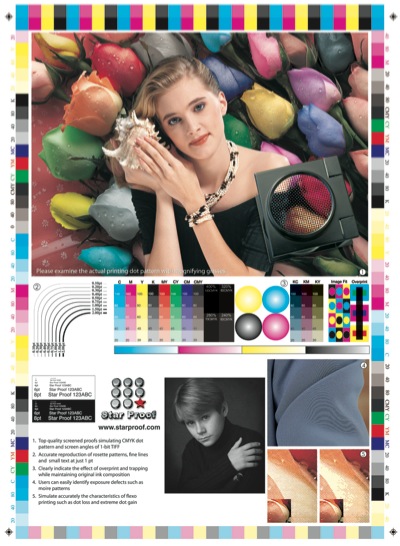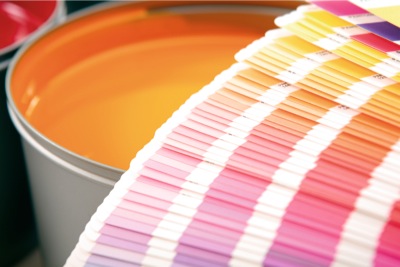Accurate formulation of ink for each press condition is necessary to achieve colour reproduction
In the second article of our series on colour management, Stefano d’Andrea, Acus Srl, and Steve Donegan, Graphic Republik, discuss how colour management extends from pre-press through to the pressroom.
Colour management, colour profiles, targets, rendering intents, Lab values, spectrophotometers.
As a printer, some of these words may seem alien, but please, read on. The following article is not only intended for those involved in pre-press, it is also for you, the printer.
The nature of the subject requires some reference to pre-press but inessence, it has been written from a pressroom perspective. It compares two similar sized printing companies which differ in their approach to colour management.
Managing colour
Colour management describes aseries of activities involving technologies that manage the pre-press and printing workflow. It exists in order to achieve a printed appearance that matches the customer’s expectation. These activities start in the pressroom, are continued in prepress and then return to the pressroom for the final print production.
To illustrate these activities, we will begin by focusing on colour appearance and consider these aspects (1) when the colour is just a solid or linework, and (2) when the colour contains halftone or tint areas which may also overlap other colours.
Solid colour
The appearance of a solid colour depends upon the characteristics of an ink in combination with other settings on a printing system, such astype of plate, mounting tape, anilox volume, substrate, etc.
Here is a basic scenario.
You need to print a green solid colour. How much is prepress involved in this? The answer is: very little.
Sure, the platemaking department may provide a plate which defines the solid area to be printed, and pre-press may be involved in producing a visually correct renditionof the solid colour through a proofing system. Pre-press may also suggest that the proof colour is only indicative and the actual printed colour may differ dependent on the aforementioned settings in the pressroom.
Pre-press would only really become involved in making adjustments if the green solid ink overprinted or was in any way connected to another colour. So what form of colour managementoccurs in the pressroom when a solid colour needs to be printed? Let’s compare the differing philosophies of Printer A and Printer B.
Printing solids
Printer A
Firstly, the correct ink is formulated for the respective colour. Printer A is aware that the colour recipe or formula will only be guaranteed to be correct for a particular volume anilox roller, substrate, plate and tape, that will be used in final production.
Actually, Printer A has more than one anilox roller with the same volume and linescreen. Such specifications were calculated in order to have an ideal volume for printing solids and increases the possibility of greater consistency. He knows the rollers will deliver a fairly identical result when printing.
Printer B
In this scenario, ink is formulated or purchased without a clear reference to the actual components which will be used in production. Printer B accepts the fact that the ink colour may not initially be an exact match on press, but he has other anilox rollers with different volumes and linescreen, and he can load more ink or reduce the ink quantity until the desired result is reached.
On top of this, he can also adjust the ink by introducing other colours into the mix until the desired result is finally reached … at least for this time.
Printer B has invested in a wider inventory of rollers and, as a consequence, allows additional time for production changes.
 Characterisation charts assist in initial press fingerprints and ongoing press colour management
Characterisation charts assist in initial press fingerprints and ongoing press colour management
Halftone colours
When halftones are involved, prepress has a greater involvement in the production workflow. Here, not only are the standard CMYK colour separations considered, but also any spot colours containing halftones. These spot colours may also interact in some way with the CMYK colours.
The final appearance of colours depends both on the characteristics of the ink for a particular print condition and the pre-press settings used. If colours are overlapping, pre-press will determine the percentage of coverage for each colour. Pre-press tools are instrumental in applying the correct dot percentage that will appear on the plate through the calculations, colour conversions and different operations that were described in the article in the April issue of FlexoTech.
When generating the file for output to plate, pre-press will aim to replicate the result achieved when the original test form was printed during the press characterisation stage. Once the plate is made and mounted, the printer must do the same; replicate the original print condition. This is a basic example of colour management in the pressroom. Again, two differing examples of what may actually happen in the pressroom when separations or colours with halftones are used in production.
Printing halftones
Printer A
Following the same principle as used for solid colours, all of the anilox rollers that are used for separations and halftones have identical specifications (albeit a higher line screen and lower volume compared to those used for solids and lineworks). The inks used for separations are also formulated at the same low volume that was determined for the reproduction of tonal values according to printer’s request.
As Printer A has invested in identical anilox rollers, he also has the possibility to measure and in the process, manage their quality. When new rollers are purchased, it is easy to print a reference step-wedge and establish whether they will produce identical results, within agreed and accepted tolerances. Tonal value reproduction for the most typical line screens are also known, managed and maintained.
Printer A has already requested his pre-press provider to add a series of colour patches to every job as he wants to monitor the consistency of the print results. It took a bit of getting used to, actually taking the time to measure and act upon the readings where necessary, but now they are invaluable.
He in turn is able to feedback a constant flow of colour information to the pre-press department via the prints. This helps ensure the colour profile that was calculated after fingerprinting is maintained. In this instance, there is a mutually beneficial exchange of information between printer and pre-press.
Printer B
As previously cited, the anilox rollers used to print the separations are not the same. In fact, it is common knowledge that in the pressroom of Printer B, the yellow requires more volume and magenta sometimes needs to be reduced in volume.
Cyan sometimes needs to be adjusted and the black ink is closer to grey in order to avoid dirty printing. There are actually six anilox rollers available for separations, with four different volumes.
There is no room for control patches and running targets: the cost of substrate is too high to allow for such sophistication and he saves money by using a reduced plate size.
Anyway, there is not enough time to delay production and measure those values. All in all, the separation inks are always the same so pre-press should only be concerned with ensuring that the dot gain compensation is correct for every job.
Whenever the printed result of a colour does not satisfy Printer B, he may change the anilox roller on press, or/and adjust ink viscosity and dilution until the target result is reached … at least for this time.
Sometimes, corrections on press are not enough. Perhaps he feels that the magenta plate is incorrect and needs to be re-made, perhaps with less dot-gain. The repro company supplying the plate does not know or understand the reason for this, it just remakes the plate because it is a large printer who it does a lot of work for. Never mind. As printer B has invested in a wider inventory of anilox rollers, he has come toaccept that on occasions, he utilises his printing press as a kind of proofing device during production.
In summary
Who are you Printer A or B?
If your production resembles printer A, congratulations.
If your production resembles printer B, some basic changes would result in cost savings and increased efficiency.
Colour management begins in the pressroom before a plate is mounted or a print is made. To begin with, it should encompass a thorough system review and analysis. This will assist in the decision-making process when choosing anilox engravings, plate, mounting tape, substrate: in fact all elements involved in the final production process.
Print characterisation should at least include the recording of tonal value reproduction when using a range of plate linescreens. The resultant information helps establish the parameters that can be both achieved and adhered to. Print characterisation also establishes what is achievable from each inking roller in the press department.
The ISO norm 12647-6:2012 mentioned in the previous colour management article contains reference to dot gain values that can be used for this operation. Once these parameters are known, they can be used to check consistency, to determine maintenance and to provide information via useful numbers about the condition of each component within the print configuration.
Of course you could use your press as an elaborate proofing device – add this colour, try this, change that. But you should consider printing by numbers instead. You are more likely to match previous results and achieve increased, managed productivity and consistency.






